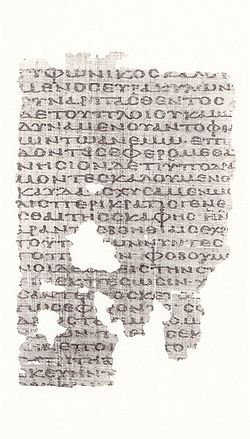| New Testament manuscript | |
 | |
| Name | P. Bodmer XVII |
|---|---|
| Text | Acts †; Catholic epistles † |
| Date | 7th century |
| Script | Greek |
| Found | Egypt |
| Now at | Bibliotheca Bodmeriana |
| Cite | Rudolf Kasser, Papyrus Bodmer XVII: Actes des Apôtres, Epîtres de Jacques, Pierre, Jean et Jude (Cologny/Geneva: 1961) |
| Size | 33 by 21 cm |
| Type | Alexandrian text-type |
| Category | I |
| Note | Acts 27:14-21 shown |
Papyrus 74 (in the Gregory-Aland numbering), designated by 𝔓74, is a copy of the New Testament in Greek. It is a papyrus manuscript of the Acts of the Apostles and Catholic epistles with lacunae. The manuscript paleographically had been assigned to the 7th century.[1]
Description[edit]
- Contents
The surviving texts are verses: Acts 1:2–28:31 †; James 1:1–5:20 †; 1 Peter 1:1–2, 7–8, 13, 19–20, 25; 2:6–7, 11–12, 18, 24; 3:4–5; 2 Peter 2:21; 3:4, 11, 16; 1 John 1:1, 6; 2:1–2, 7, 13–14, 18–19, 25–26; 3:1–2, 8, 14, 19–20; 4:1, 6–7, 12, 18–19; 5:3–4, 9–10, 17; 2 John 1, 6–7, 13; 3 John 6, 12; Jude 3, 7, 11–12, 16, 24.
- Text
Despite the late date, it is an important manuscript and excellent witness for the book of Acts.[2]
The Greek text of this codex is a representative of the Alexandrian text-type. Aland ascribed it as a "strict text", and placed it in Category I.[1]
- Acts 12:25 it reads εξ Ιερουσαλημ (from Jerusalem) along with A, 33, 69, 630, 2127; majority reads εις Ιερουσαλημ (to Jerusalem);[3]
- It does not contain Acts 15:34 as codices Sinaiticus, Alexandrinus, Vaticanus, E, Ψ, Byz.[4]
- Acts 20:28 it reads του κυριου (of the Lord) – A C* D E Ψ 33 36 453 945 1739 1891, instead of the Alexandrian του Θεου (of the God), or the Eastern Roman (Byzantine) του κυριου και του Θεου (of the Lord and God).[5]
- Acts 27:16 – καυδα (name of island), this reading is supported only by Vaticanus, 1175, Old-Latin version, Vulgate, and Peshitta.[6]
- Present location
It is currently housed at the Bibliotheca Bodmeriana (P. Bodmer XVII) in Cologny.[1][7]
See also[edit]
References[edit]
- ^ a b c Aland, Kurt; Aland, Barbara (1995). The Text of the New Testament: An Introduction to the Critical Editions and to the Theory and Practice of Modern Textual Criticism. Erroll F. Rhodes (trans.). Grand Rapids: William B. Eerdmans Publishing Company. p. 101. ISBN 978-0-8028-4098-1.
- ^ Philip W. Comfort, Encountering the Manuscripts. An Introduction to New Testament Paleography & Textual Criticism, Nashville, Tennessee: Broadman & Holman Publishers, 2005, p. 72.
- ^ UBS3, p. 464.
- ^ NA26, p. 478.
- ^ NA26, p. 384.
- ^ NA26, p. 403.
- ^ "Liste Handschriften". Münster: Institute for New Testament Textual Research. Retrieved 27 August 2011.
Further reading[edit]
- Rudolf Kasser, Papyrus Bodmer XVII: Actes des Apôtres, Epîtres de Jacques, Pierre, Jean et Jude (Cologny/Geneva: 1961).
External links[edit]
- Robert B. Waltz. NT Manuscripts: Papyri, Papyri 𝔓74.
Well, that’s interesting to know that Psilotum nudum are known as whisk ferns. Psilotum nudum is the commoner species of the two. While the P. flaccidum is a rare species and is found in the tropical islands. Both the species are usually epiphytic in habit and grow upon tree ferns. These species may also be terrestrial and grow in humus or in the crevices of the rocks.
View the detailed Guide of Psilotum nudum: Detailed Study Of Psilotum Nudum (Whisk Fern), Classification, Anatomy, Reproduction